Topics in Biology
Cellular respiration in biology Len Academy biology mock questions for waec Len Academy biology midterm questions for SS1, 2nd Term Characteristics of saltwater habitat Aquatic habitat explained with its types Types of habitat: Terrestrial habitat explained with examples What is habitat? Difference between plant cell and animal cell Nucleus explained with its structures Nucleus explained with its types and functions Organelles of the cell explained with their characteristics Eukaryotic cell explained with its characteristics Prokaryotic cell explained with its structure Characteristics of prokaryotic cell Concept of cell Cell theory in biology Importance and limitations of ecological pyramid Protists explained with their characteristics Contents of the scrotum: Epididymis, vas deferens, spermatic cord and cremaster muscle Tropical savanna explained with its characteristicsAcademic Questions in Biology

From the above diagram, which of the organ below isn't a requirement for the male reproductive system?
A. Bladder
B. Ureter
C. Glans Penis
D. Testis
E. Bulbourethral Gland
F. Epididymis
A walnut shaped male accessory sex organ located between the bladder and penis is the _____.
A. Ductus Ejaculatorii
B. Bulbourethral Gland
C. Prostate Gland
D. Ductus Deferens
E. Seminal Vesicles
F. Epididymis
In a food chain, the primary consumers are classified under trophic level _____.
A. Zero
B. One
C. Two
D. Three
E. Four
F. Five
Cold blooded animals are referred to as _____.
A. Homeotherms
B. Endotherms
C. Poilokitherms
D. Ectotherms
E. Thermotherms
F. None of the above
All reptiles are vertebrates.
A. True
B. False
_____ cells are responsible for the formation of osteoblasts.
_____ is a bone that constitute the axial skeleton.
Which of the following is false concerning cartilages and bones?
The nucleus is a membrane-bound, spherical-shaped and well-defined organelle present in eukaryotic cells. In fact, the presence of a definite nucleus distinguishes eukaryotes from prokaryotes.
The nucleus is absent in monerans. This includes the bacteria and blue green algae. Generally, it is not well defined in prokaryotic organisms.
Please read more on prokaryotes here.
The nucleus accounts for about 10% of the cell's volume, and is enclosed in a membrane (called the nuclear envelope). This double layered nuclear membrane separates the contents of the nucleus from the rest of the cellular cytoplasm. However, the nuclear membrane is often seen to be continuous with another organelle, the endoplasmic reticulum.
Please read an introduction to cell organelle here.
The nuclear envelope comprises of phospholipid molecules forming a lipid bilayer. A nuclear pore is present on the nuclear envelope. These pores are a part of some complex proteins called the nuclear pore complex (NPC). Depending on the cell type, the cells of human and other vertebrates are said to have about 1,000 nuclear pore complexes within their nuclear envelope.
Functionally, the nuclear envelope gives the nucleus its shape, and is permeable to certain substances like RNA materials, molecules and ions. In this regard, it coordinates the movement of substances into and outside the nucleus through its pores.
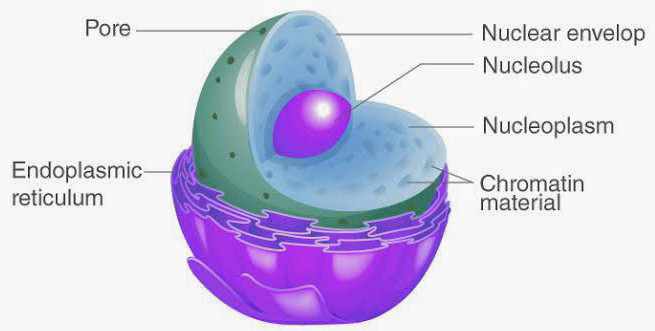
Diagram showing the structure of a nucleus
Please read on eukaryotes and their characteristics here.
The contents of the nucleus are made up of various key structures. They include the following:
Nuclear Membrane
Nucleoplasm
Genetic Materials (DNA and proteins, or chromatin)
Nucleolus
The nucleoplasm (also known as karyoplasm, nuclear sap or karyolymph) is a gel-like, clear, transparent, and colloidal liquid substance present within the nucleus, and is bounded by the nuclear membrane. Present within the nucleoplasm are large quantities of nucleoproteins, alongside small amounts of minerals, ribose sugars, dissolved proteins, nucleic acids, enzymes and nucleotides. Meanwhile, understand that the karyoplasm is quite different from the cytoplasm.
The nucleoplasm suspends the contents of the nucleus, while simultaneously supporting its spherical shape alongside the nuclear envelope.
The nucleus contains the genetic material of the cell, and that's the DNA (Deoxyribonucleic Acid) which constitutes the chromosomes. Simply put, strings of DNA and proteins make up the chromosomes. Together, the DNA and protein molecules are called chromatin. In this regard, the ultimate function of the cell's nucleus is to control gene expression.
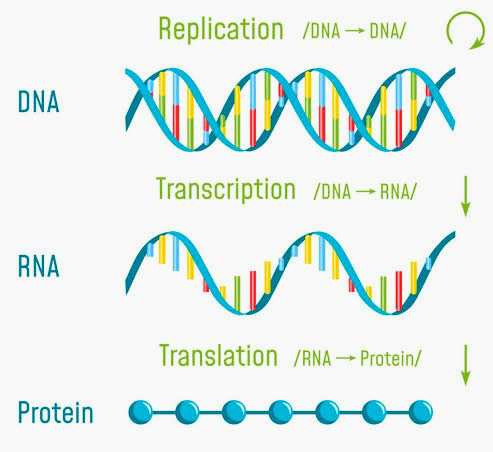
DNA is replicated, copied into RNA (through transcription), which is translated into proteins.
You can read the concept of cell theory here.
Within the nucleus, the information in DNA is copied into various messenger RNA (RiboNucleic Acid) molecules, with each of these encoding the information for one protein or more (depending on the organism). This process is termed DNA transcription. The mRNA molecules are then transported through the nuclear membrane (which is semipermeable) into the cytoplasm. Here, the mRNA molecules are translated on the ribosomes through a process termed RNA translation, where they serve as templates for specific protein synthesis.
You can read keypoints for students in basic science here.
The nucleus assists in the processing of pre-mRNA molecules by undergoing post-transcriptional modification. This function is carried out in the nucleus before its exportation to the cytoplasm.
The nucleolus is a prominent structure present in the nucleus of eukaryotic cells. It serves as the site of ribosome production and assembly. The nucleolus is derived from DNA, RNA and protein molecules. Scientist are considering the nucleolus as a potential site for treating cancerous cells.
You can attempt Len Academy questions and answers in basic science here.
From the above explanations thus far, below is a summary of the structures of a cell's nucleus.
It is often the most prominent organelle in the cell and can account for 10% of its volume. Please read an introduction to viruses here.
It is bounded by a membrane termed the nuclear envelope, and this separate the contents of the nucleus from the cytoplasm. The nuclear envelope is semipermeable.
It contains a gel-like fluid called the nucleoplasm or karyoplasm.
You can read on bone cells here.
The nucleolus is a prominent structure present in the nucleus. In fact, it is considered the largest structure in the nucleus.
Strings of genes making up chromosomes are present in the nucleus.
Please read on the types and functions of nucleus here.
Kindly share this article via the links below:

Please click here to contact Alfred if you require any of the following services:
If you need a standard website at an affordable price.
Online training on the academic subjects: biology, chemistry and basic science.
If you require an advanced smart school management system (web application) for your school.
Click here to read on Len Academy Smart School Software.
Please click here to follow Len Academy on Google News.
Amazing facts in Biology
Russia is home to the largest area of forest in our world with a land mass of 815 million hectares
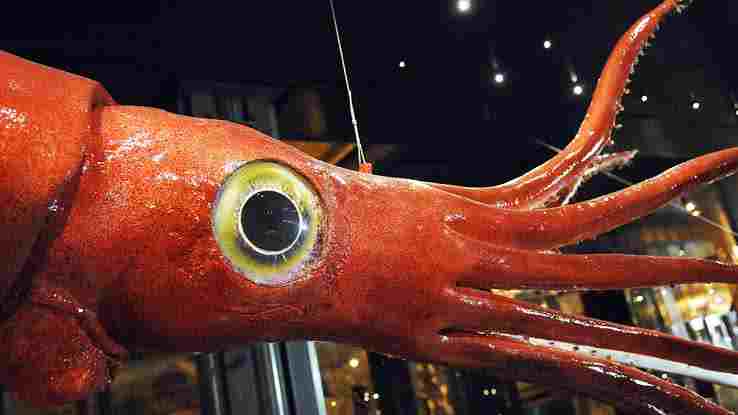
Giant squid lives deep in the ocean and they have the largest eyes in the world
The movements of the fingers are controlled by muscles of the palms and forehands
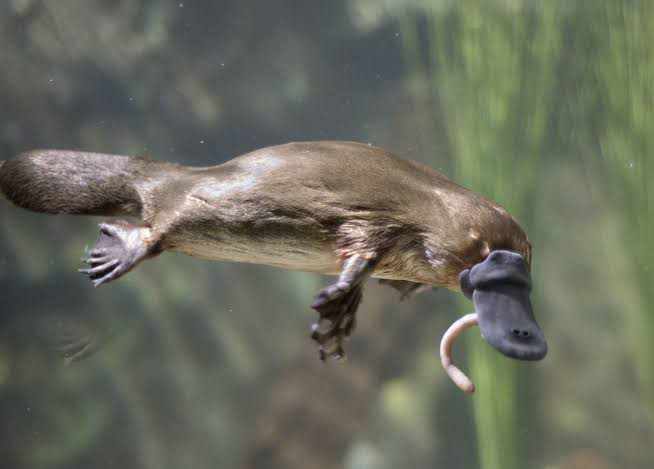
Platypus (sometimes referred to as the duck-billed platypus) is an egg-laying, semiaquatic mammal found in eastern Australia. It has no stomach and as such, its food goes from the mouth through the esophagus and directly to their intestines.

Pufferfish contain a toxin called tetrodotoxin. This makes them foul tasting and poisonous to predators. Tetrodotoxin is about 1,200 times more poisonous than cyanide, and there is enough toxin in one pufferfish to kill 30 adult humans. Unfortunately, there isn't any known antidote to this poison.
Interestingly, a delicacy in Japan (called fugu) is made from pufferfish. This meal is very expensive, and must be prepared by trained and licensed chefs. An improper preparation of fugu may lead to the customer's death. Sadly, such deaths are recorded annually
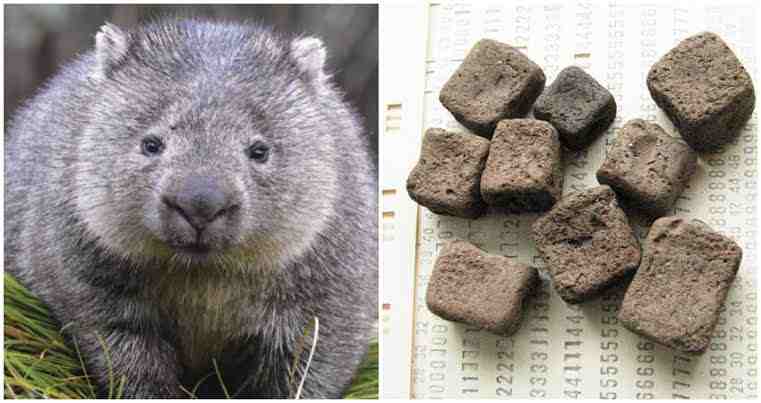
Wombats are the only animal with a cube-shaped poo. They can stack up these cube-shaped poo, marking their territory with it

Robert Wadlow (1918–1940) remains the tallest man ever recorded in the Guinness World Records. He was an American who stood at 8 feet, 11 inches.
An abnormally enlarged pituitary gland had resulted into Robert Wadlow's giant size.
Cockroach is the fastest land animal on six legs

Like humans, all apes laugh when tickled

An ostrich's eye is bigger than its brain
Notable points in Biology

An artery is composed of three layers:
The outermost layer is termed tunica adventitia (or tunica external). It consist mainly of collagen fibres and connective tissues that anchors the arteries to other nearby tissues.
The middle layer is named tunica media. It is made up of smooth muscles and elastic fibres that supports the artery in conveying blood at high pressures.
The inner layer is called tunica intima (or tunica internal). It is lined by a smooth tissue called endothelium, and is made up of a fine network of connective tissues.
All living organisms possess various features in order to survive in their environment. This is the concept of adaptation. As an instance, a fish is able to live in water because it has gills and fins.
Also, a camel is able to survive in the desert because it has large feet to aid walking on sand without sinking. It also has long eyelashes to help protect it from the blowing sand and wind.
Plants are also able to live in different habitats because they have the required adaptive features towards that habitat. For instance:
Plants that live in/on water are termed hydrophytes.
Plants that live on land with moderate amount of water are termed mesophytes.
Plants that live on deserts or arid lands are termed xerophytes.
The point is:
All organisms have various features on them that enables them adapt in their habitat
For a thing to be considered living, it must possess all the basic characteristics of life. These include:
Movement
Respiration
Nutrition
Irritability or Sensitivity
Growth
Excretion
Reproduction
Death
Adaptation
Competition
Please read the explanations on all the basic characteristics of life here
During strenuous exercises like sprinting or running, your body may actually work in the shortage of oxygen. During this time, your body owes oxygen (called oxygen debt) and it must be replenished or repayed after the exercise is stopped. This is why you breathe excess of oxygen after you stopped the exercise.
This is the concept of anaerobic respiration

A food chain is a diagram that shows the relationship between plants and animals within a habitat on the basis of how they rely on each other for food.
Note: Habitat is a place where an organism live. It is of three types: